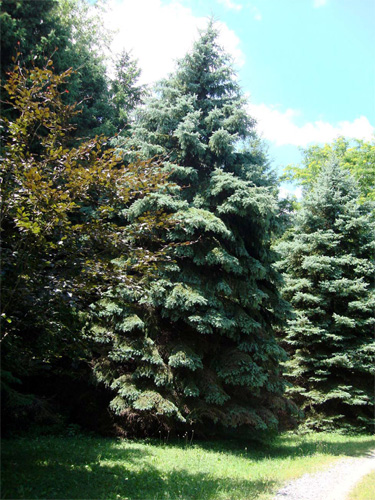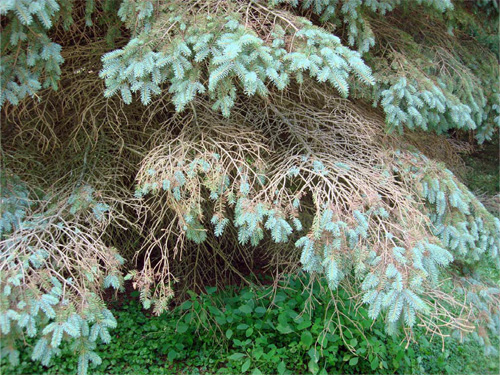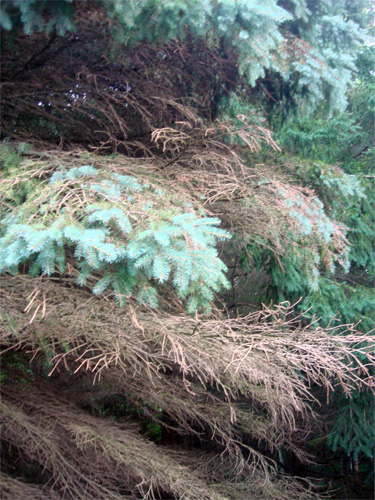Spruce tree disease symptoms are associated with fungal pathogens and are progressing through time
What’s causing the stress that’s allowing the pathogens Phomopsis and Diplodia to attack and kill branches on spruce trees in Michigan?
We have been receiving more contacts from people noticing the spruce decline around the state. Two weeks ago we first reported on a severe decline of spruce trees throughout Michigan (see Spruce problems are probably caused by more than a single agent). Last week we reported that the malady appears to consist of two previously known diseases of spruce, that is, a branch death and needlecasting (see Spruce tree problem shows symptoms of both needlecast and branch death). It was not immediately apparent what was causing these symptoms.
This week in our laboratory we determined that two different pathogens, Phomopsis and Sphaeropsis (better known as Diplodia) can be found on the dead and dying branches of these trees. A third fungus has also been isolated from the branches, but identification will take at least another week.
Both Phomopsis and Diplodia are known as pathogens of various species of conifer trees and they can kill branches. However, they are typically thought of as stress pathogens, that is, they infect trees undergoing some severe level of stress. What could be uniformly stressing these trees across the Lower Peninsula such that so many spruce trees are afflicted with the stress pathogens? How would you stop this branch death? Would you try to find and reduce the stress or use fungicide applications across the state to control the problem? The former option would be the best for the wallet and environment, but can we find the stress? Another option is that these pathogens have changed or mutated and have become more aggressive. It would be difficult to imagine what could have changed two common pathogens at the same time to become more aggressive on the same trees; that is not a probable option at this point.
Another possibility is the stressor being another disease-causing pathogen, such as the traditional needlecasting pathogen Rhizosphaera or the newly introduced fungus that grows on the needles called Stigmina or an attack by both. A conifer that is losing its needles loses the ability to photosynthesize sugars used for the health of the tree. It is well known that diseases that cause needles to cast or drop off can ultimately lead to the death of trees. So, it is plausible that the death of the branches and trees can occur via continuous re-infection by needle-loving pathogens. Is this needlecast the stress that is allowing the pathogens Phomopsis and Diplodia to attack and kill branches on the spruce trees in Michigan?
We have provided here some photos of the same tree at two different times. In Photos 1 and 2, you can see a Colorado blue spruce from its east and west aspects in July 2009. From a distance, the tree looks healthy with vigorous growth. But upon closer inspection (Photo 3), there are sections of needlecast and branch death around the base of the tree that are beginning to become noticeable, hence the reason the photos were taken in 2009. In Photos 4 and 5, you can see the same tree, two years later, from the same aspects showing more branch death. A close up view (Photo 6) shows discolored needles, branches devoid of previous years’ needles (needlecasting), and dead branches. The progression is occurring rapidly and the tree has lost its aesthetic value in the landscape.

Photo 1. Thirty-year-old Colorado blue spruce tree photographed
in 2009. East aspect of tree.

Photo 2. Thirty-year-old Colorado blue spruce tree photographed
in 2009. West aspect of tree.

Photo 3. Close up photo of lower branches on 2009-photographed tree, indicating some
problems on the tree were already present in the summer of 2009.

Photo 4. East aspect of the same 30-year-old Colorado blue spruce
as seen in Photos 1-3. This time the photo was taken in mid-July
2011. The disease has progressed from the lower branches up to
about the lower third of the tree.

Photo 5. West aspect of the same 30-year-old Colorado blue spruce
as seen in Photos 1-3. This time the photo was taken in mid- July
2011. The disease has progressed from the lower branches up to
about the lower third of the tree.

Photo 6. Close up of lower branches on the 2011-photographed tree
showing the total involvement of the lower branches. Many of the
lower branches showing only needlecast in 2009 are now dead.
Related resources:
- Spruce problems are probably caused by more than a single agent, Dennis W. Fulbright, Mursel Catal, Sara Stadt and Jill O'Donnell, Michigan State University Extension, Department of Plant Pathology
- Spruce tree problem shows symptoms of both needlecast and branch death, Dennis W. Fulbright, Mursel Catal, Sara Stadt and Jill O'Donnell, Michigan State University Extension, Department of Plant Pathology
- Two more spruce problems that are not herbicide related, Bert Cregg, MSU Departments of Horticulture and Forestry
Dr. Fulbright's work is funded in part by MSU's AgBioResearch.



 Print
Print Email
Email

